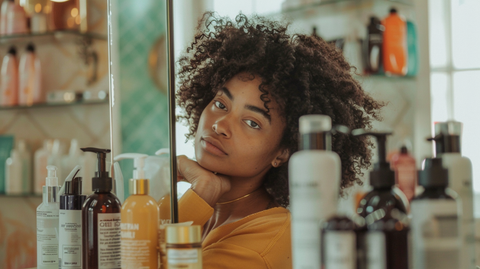Comprehension of various curl types' unique challenges and needs is essential in luxury virgin hair extensions. Differentiating between the diverse patterns and textures is not just a matter of appearance but a crucial aspect of hair care and styling. This guide aims to demystify the complexity of curly hair, offering insights and practical advice for identifying and nurturing every type of hair curls, from the slightest wave to the tightest coil.
Curl Typing: A Comprehensive Approach
The concept of curl typing, pioneered by hair stylist Andre Walker, is more than just categorizing hair. It's a nuanced method of understanding the diverse spectrum of curls. This system, ranging from 1 to 4, with subcategories A to C, is not just about labeling; it's about appreciating the unique characteristics of each type of hair curls. For instance, type 1A hair, with its pin-straight appearance, demands specific styling approaches, contrasting with the robust texture of type 4 hair.
Decoding Your Curl Pattern
Identifying your curl pattern is more than a superficial examination; it's an exploration starting from the scalp. According to Gaia Tonanzi, a senior brand manager at Curlsmith, the key lies in understanding the shape of hair follicles. For instance, curly hair follicles' oval or asymmetrical shape gives rise to the distinctive elliptical curl pattern, starkly contrasting the uniform growth of straight hair from round follicles. It's crucial to remember that most individuals possess a blend of curl patterns, underscoring the need for personalized hair care.
Navigating Through Types 2, 3, and 4

Navigating the intricate world of types of hair curls is akin to embarking on a journey through a diverse landscape of hair textures. Each curl type, from 2 to 4, presents its own set of characteristics, challenges, and beauty. This exploration is not just about identifying your hair type; it's about unlocking the secrets to optimally caring for and enhancing your natural curls. As we delve into Type 2, known for its versatile waves, we uncover the first layer of this rich and varied spectrum.
Type 2: The Versatile Waves
Type 2 hair, spanning from fine to coarse textures, includes everything from subtle waves to more pronounced curls. Understanding this type's nuances, from the slightly curled 2A to the more defined and frizz-prone 2C, is crucial for practical styling and product selection. For instance, 2A hair benefits from volumizing products like light mousse, while 2C requires moisture-rich formulations to tame frizz.
Type 3: The Dynamic Curls
Type 3 hair, known for its loopy S-patterns to tight ringlets, demands a delicate balance of touch and product application. The fragility of 3A curls necessitates minimal handling, whereas the springy nature of 3B ringlets calls for moisture-attracting humectants. The densely packed 3C curls, prone to humidity and frizz, require a careful layering of mousse and styling creams.
Type 4: The Intense Coils
Type 4 hair is characterized by its tight, small, kinky curls. This type of hair curls ranges from the visible S-shaped coils of 4A to the sharp Z-shaped angles of 4B and the fragile, shrinkage-prone 4C. Each subtype demands specific care, from moisture-rich creams for 4A to gentle cleansing conditioners for 4B and heavy, nourishing oils and creams for 4C.
Expert Recommendations for Each Curl Type

Professional hairstylists stress the importance of tailored care for each curl type. For instance, Andrew DiMeo of Nunzio Saviano Salon emphasizes using sulfate-free shampoos and styling creams for 2C hair and the benefits of humectant-rich gels for 3B curls. For 4C hair, the focus shifts to avoiding sulfates and embracing natural oils and heavy creams to maintain moisture.
Conclusion
In luxury virgin hair extensions, understanding and caring for various types of hair curls is not just a matter of aesthetic preference but a critical component of hair health and styling. This guide provides a foundational understanding of the unique needs and characteristics of different curl types, empowering individuals to embrace and care for their natural curls with confidence and expertise.
Frequently Asked Questions
What is Curl Typing and How Does it Help in Choosing Hair Extensions?
Curl typing, developed by hair stylist Andre Walker, categorizes hair into types 1 to 4 with subcategories A to C. This method aids in selecting hair extensions by matching them to your natural curl pattern, ensuring a seamless and natural look.
How Can I Identify My Curl Pattern Accurately?
To identify your curl pattern, start by examining your hair at the scalp level. Look at the shape of your hair follicles - curly hair follicles tend to be oval or asymmetrical. Remember, having a mix of curl patterns is common, so choose products and extensions that cater to your predominant curl type.
What are the Key Characteristics of Type 2, 3, and 4 Curls?
Type 2 curls range from fine to coarse with subtle to pronounced waves. Type 3 hair has loopy S-patterns to tight ringlets and requires a balance of touch and product application. Type 4 hair features tight, small, kinky curls and needs moisture-rich products and gentle care.
Are There Specific Hair Care Tips for Each Curl Type?
Yes, each curl type requires tailored care. For instance, Type 2C hair benefits from sulfate-free shampoos and styling creams, Type 3B curls need humectant-rich gels, and Type 4C hair should avoid sulfates and use heavy, nourishing oils and creams.
Why is Understanding Curl Types Important in Luxury Virgin Hair Extensions?
Understanding curl types is crucial in luxury virgin hair extensions for achieving a natural and cohesive look. It helps select the right type of extension and informs the appropriate care and styling techniques to maintain hair health and appearance.
